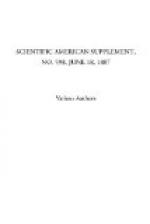A remarkable mass of rock crystal has been received by Messrs. Tiffany & Co. from a locality near Cave City, Va. Although this mass weighs 51 pounds, it is but a fragment of the original crystal, which weighed 300 pounds, and which was broken in pieces by the ignorant mountain girl who found it. The fragment, as it is, will furnish slabs 8 inches square and from 1/3 to 1 inch thick. The original crystal would have furnished a ball from 41/2 to 5 inches in diameter, and almost perfect. A number of fine agates of various kinds were found by Mr. F.C. Yeomans at the same locality.
The meccanite from Cumberland, R.I., is often spotted with white quartz. It has been cut into oval stones several inches in length, which take a fine polish. This quality, coupled with its hardness, makes it a desirable ornamental gem stone.
Mr. Kunz records the discovery, by himself, in the largest mass of the Glorieta Mountain (Santa Fe County, N.M.), of pieces of peridot of sufficient transparency to afford gems one-fifth of an inch in length.
Large quantities of turquoise from Los Cevillos, N.M., have been sold, both as cabinet specimens and gems; but, unfortunately, many of those of the finest color have been found to be artificially colored.
Malachite in large masses has been found at the Copper Queen mine at Bisbee, Oregon. One of these masses weighed 15 pounds and others were quite as large. All were of good enough quality and large enough for table tops.
In conclusion, Mr. Kunz says that “the National Museum collection of gems, formed by Prof. F.W. Clarke, is now one of the most complete, for species, in the United States, and as many of the gems are of more than average merit, and all can have access to them, this is one of the best opportunities afforded the student in this country.”
* * * * *
THE BRAZIL NUT.
[Illustration: THE BRAZIL NUT.]
Every one is acquainted with the hard-shelled, triangular fruit called the Brazil nut, but there are, perhaps, but few who know anything about the tree that produces it, or its mode of growth. The Brazil nut tree belongs to a genus of Lecythidaceae of which there is only one species, Bertholletia excelsa. This tree is a native of Guiana, Venezuela, and Brazil. It forms large forests on the banks of the Amazons and Rio Negro, and likewise about Esmeraldas, on the Orinoco, where the natives call it juvia. The natives of Brazil call the fruit capucaya, while to the Portuguese it is known as castana de maranon.
The tree is one of the most majestic in the South American forests, attaining a height of 100 or 150 feet. Its trunk is straight and cylindrical, and measures about 3 or 4 feet in diameter. The bark is grayish and very even. At a distance, the tree somewhat resembles a chestnut. Its branches are alternate, open, very long, and droop toward the earth. The leaves are alternate, oblong, short petioled, nearly coriaceous, about 2 feet long by 6 inches wide, entire or undivided, and of a bright green color. The flowers have a two-parted, deciduous calyx, six unequal cream-colored petals, and numerous stamens united into a broad, hood-shaped mass, those at the base being fertile, and the upper ones sterile.




